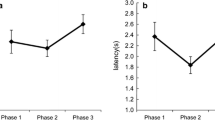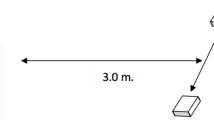Abstract
Even young humans show sensitivity to the accuracy and reliability of informants’ reports. Children are selective in soliciting information and in accepting claims. Recent research has also investigated domestic dogs’ (Canis familiaris) sensitivity to agreement among human informants. Such research utilizing a common human pointing gesture to which dogs are sensitive in a food retrieval paradigm suggests that dogs might choose among informants according to the number of points exhibited, rather than the number of individuals indicating a particular location. Here, we further investigated dogs’ use of information from human informants using a stationary pointing gesture, as well as the conditions under which dogs would utilize a stationary point. First, we explored whether the number of points or the number of individuals more strongly influenced dogs’ choices. To this end, dogs encountered a choice situation in which the number of points exhibited toward a particular location and the number of individuals exhibiting those points conflicted. Results indicated that dogs chose in accordance with the number of points exhibited toward a particular location. In a second experiment, we explored the possibility that previously learned associations drove dogs’ responses to the stationary pointing gesture. In this experiment, dogs encountered a choice situation in which artificial hands exhibited a stationary pointing gesture toward or away from choice locations in the absence of humans. Dogs chose the location to which the artificial hand pointed. These results are consistent with the notion that dogs may respond to a human pointing gesture due to their past-learning history.
Similar content being viewed by others
References
Agnetta B, Hare B, Tomasello M (2000) Cues to food locations that domestic dogs (Canis familiaris) of different ages do and do not use. Anim Cogn 3:107–112
Asch SE (1956) Studies of independence and conformity: 1. A minority of one against a unanimous majority. Psychol Monogr 70:1–70
Bates E, Benigni L, Bretherton I, Camaioni L, Volterra V (1979) The emergence of symbols: cognition and communication in infancy. Academic Press, New York
Birch SAJ, Vauthier SA, Bloom P (2008) Three and 4-year-olds spontaneously use others’ past performance to guide their learning. Cognition 107:1018–1034
Butterworth G (1995) Origins of mind in perception and action. In: Moore C, Dunham PJ (eds) Joint attention: its origins and role in development. Lawrence Erlbaum, Hillsdale, pp 29–40
Carlson SM, Moses LJ, Hix HR (1998) The role of inhibitory processes in young children’s difficulties with deception and false belief. Child Dev 69:672–691
Corriveau KH, Harris PL (2010) Preschoolers (sometimes) defer to the majority in making simple perceptual judgments. Dev Psychol 46:437–445
Corriveau KH, Fusaro M, Harris PL (2009) Going with the flow: preschoolers prefer nondissenters as informants. Psychol Sci 20:372–377
Couillard N, Woodward A (1999) Children’s comprehension of deceptive points. Br J Dev Psychol 17:515–521
De Los Reyes A, Thomas SA, Goodman KL, Kundey SMA (2013) Principles underlying the use of multiple informants’ reports. Annu Rev Clin Psychol 9:123–149
Dorey NR, Udell MR, Wynne CL (2009) Breed differences in dogs’ sensitivity to human points: a meta-analysis. Behav Process 81:409–415
Fiset S, Beaulieu C, Landry F (2003) Duration of dogs’ (Canis familiaris) working memory in search for disappearing objects. Anim Cogn 6:1–10
Franco F, Butterworth G (1996) Pointing and social awareness: declaring and requesting in the second year. J Child Lang 23:307–336
Fusaro M, Harris PL (2008) Children assess informant reliability using bystanders’ non-verbal cues. Dev Sci 11:781–787
Hare B, Call J, Tomasello M (1998) Communication of food location between human and dog (Canis familiaris). Evol Commun 2:137–159
Hare B, Call J, Tomasello M (1999) Domestic dogs (Canis familiaris) use human and conspecific social cues to locate hidden food. J Comp Psychol 113:246–254
Harris PL, Pasquini ES, Duke S, Asscher JJ, Pons F (2006) Germs and angles: the role of testimony in young children’s ontology. Dev Sci 17:757–758
Haun DM, Tomasello M (2011) Conformity to peer pressure in preschool children. Child Dev 82:1759–1767
Kundey SMA, De Los Reyes A, Arbuthnot J, Allen R, Coshun A, Molina S, Royer E (2010) Domesticated dogs’ (Canis familiaris) response to dishonest human points. Int J Comp Psychol 23:201–215
Kundey SMA, German R, De Los Reyes A, Monnier B, Swift P, Delise J, Tomlin M (2012) Domestic dogs’ (Canis familiaris) choices in reference to agreement among human informants on location of food. Anim Cogn 15:991–997
Lakatos G, Soproni K, Dóka A, Miklósi Á (2009) A comparative approach to dogs’ (Canis familiaris) and human infants’ understanding of various forms of pointing gestures. Anim Cogn 12:621–631
Marshall-Pescini S, Prato-Previde E, Valsecchi P (2011) Are dogs (Canis familiaris) misled more by their owners than by strangers in a food choice task? Anim Cogn 14:137–142
McKinley J, Sambrook TD (2000) Use of human-given cues by domestic dogs (Canis familiaris) and horses (Equus caballus). Anim Cogn 3:13–22
McMahon S, Macpherson K, Roberts W (2010) Dogs choose a human informant: metacognition in canines. Behav Proc 85:293–298
Miklósi Á, Polgárdi R, Topál J, Csányi V (1998) Use of experimenter-given cues in dogs. Anim Cogn 1:113–121
Osthaus B, Lea SEG, Slater AM (2005) Dogs (Canis lupus familiaris) fail to show understanding of means end connections in a string pulling task. Anim Cogn 8:37–47
Petter M, Musolino E, Roberts WA, Cole M (2009) Can dogs (Canis familiaris) detect human deception? Behav Process 82:109–118
Riedel J, Buttelmann D, Call J (2006) Domestic dogs (Canis familiaris) use a physical marker to locate hidden food. Anim Cogn 9:27–35
Russell J, Mauthner N, Sharpe S, Tidswell T (1991) The ‘windows task’ as a measure of strategic deception in preschoolers and autistic subjects. Br J Dev Psychol 9:331–349
Schaffer HR (1984) The child’s entry into a social world. Academic Press, London
Sherif M (1936) The psychology of social norms. Harper, New York
Soproni K, Miklósi Á, Topál J, Csányi V (2001) Comprehension of human communicative signs in pet dogs. J Comp Psychol 115:122–126
Soproni K, Miklósi Á, Topál J, Csányi V (2002) Dogs’ (Canis familiaris) responsiveness to human pointing gestures. J Comp Psychol 116:27–34
Topál J, Byrne R, Miklósi A, Csányi V (2006) Reproducing human actions and action sequences: “Do as I do!” in a dog. Anim Cogn 9:355–367
Udell MAR, Giglio RF, Wynne CDL (2008) Domestic dogs (Canis familiaris) use human gestures but not nonhuman tokens to find hidden food. J Comp Psychol 122:84–93
Acknowledgments
We would like to thank Rebecca German, Sabrina Molina, and Meghan Tomlin for their assistance in data collection, coding, and participant recruitment.
Author information
Authors and Affiliations
Corresponding author
Rights and permissions
About this article
Cite this article
Kundey, S.M.A., Delise, J., De Los Reyes, A. et al. Domestic dogs’ (Canis familiaris) choices in reference to information provided by human and artificial hands. Anim Cogn 17, 259–266 (2014). https://doi.org/10.1007/s10071-013-0658-3
Received:
Revised:
Accepted:
Published:
Issue Date:
DOI: https://doi.org/10.1007/s10071-013-0658-3




